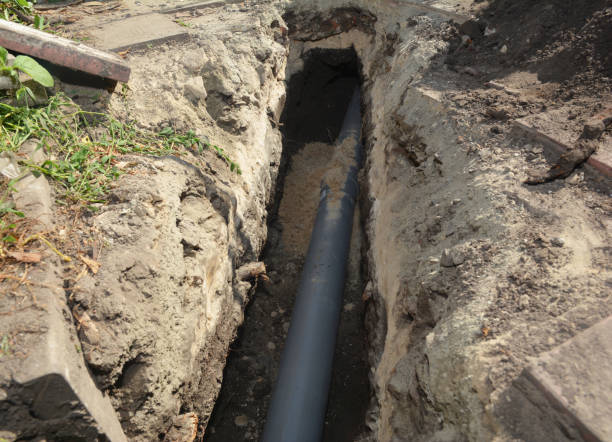Sewer Line Repair in Fullerton, CA
Sewer line repair in Fullerton, CA with expert diagnostics, trenchless options, and prompt emergency service. Schedule an inspection today.
Sewer Line Repair in Fullerton, CA
A failing sewer line quickly becomes more than an inconvenience — it threatens your home, health, and landscaping. If you live in Fullerton, CA, signs like slow drains, recurring backups, or persistent odors usually mean a buried problem that needs professional attention.

Common sewer line failure signs in Fullerton homes
Recognizing early warning signs reduces damage and repair cost. Watch for:
- Multiple slow drains or repeated clogs across sinks, tubs, and toilets (not just a single fixture).
- Sewage backups into toilets, showers, or floor drains, especially after using water in multiple areas.
- Sewage odors in the yard, basement, or around drain inlets.
- Gurgling sounds coming from drains or toilets.
- Soggy or unusually green patches in the yard, depressions in the lawn, or unexpected sinkholes.
- Increased rodent or insect activity near the foundation or sewer-run areas.
These symptoms often signal a blockage, pipe collapse, root intrusion, or broken joints in the lateral between your home and the city main.
Why sewer lines fail in Fullerton
Fullerton's mature neighborhoods and local conditions create specific risks:
- Many homes have older clay, cast-iron, or brittle jointed pipes that become fragile with age.
- Mature trees common in Fullerton send aggressive roots toward water sources; roots can enter joints and crush pipes.
- Southern California soils and seasonal wet/dry cycles can shift ground and stress buried piping.
- Urban infill, driveway and hardscape changes, or recent construction can alter grade and damage lines.
Understanding these local factors helps choose the most effective repairs and mitigation.
Diagnostics: camera inspection, hydro-jetting, and more
Accurate diagnosis prevents unnecessary excavation and ensures the right repair:
- Video camera inspection: A push-rod camera identifies blockages, cracks, root intrusion, pipe bellies, offsets, and exact pipe location. Video provides a clear basis for repair recommendations.
- Hydro-jetting: High-pressure water cleaning removes grease, scale, and roots to restore flow. Often used as a follow-up to camera work and can be a long-term maintenance tool.
- Smoke or dye testing: Helps locate leaks and confirm flow patterns when surface symptoms are ambiguous.
- Utility locating and soil assessment: Required before excavation or trenchless work to map utilities and evaluate access.
These diagnostics keep repairs targeted and minimize time and disturbance.
Repair options (what each involves and when they make sense)
- Trenchless pipe lining (cured-in-place pipe, CIPP): A resin-soaked liner is inserted and cured inside the existing pipe to form a new seamless pipe. Best when the line is intact enough to host the liner and when homeowners want minimal landscaping or hardscape disruption. Typical life extension: decades.
- Spot repair: Excavation limited to the damaged section to replace or patch a small area. Good when damage is isolated (e.g., one collapsed joint) and surrounding pipe is sound.
- Full repiping (lateral replacement): Complete replacement of the lateral from the house to the main. Necessary for widespread corrosion, extensive collapse, or repeatedly failing older materials. Allows upgrade to modern materials (PVC or HDPE) that resist root intrusion and corrosion.
- Root barriers and mechanical root removal: Used alongside repairs to reduce future root problems.
Each option has trade-offs between upfront cost, longevity, and disruption; camera findings guide the choice.
Emergency response and scheduling
Sewer backups are health hazards requiring prompt action. Emergency response usually follows a rapid assessment to contain contamination and protect living areas, then immediate temporary measures (pumping, bypass lines) while planning permanent repairs. Non-emergency repairs are scheduled based on the diagnostic results and permit timelines. In Fullerton, coordinating with municipal schedules and contractors for access can affect start dates.
Typical project timeline
- Inspection and estimate: 1 business day for scheduling, hours on-site for camera work and assessment.
- Permit pull and approvals: Varies by city and scope; minor repairs may be same- or next-day, while larger repipes or new connections can take 1-2 weeks or longer.
- Repair work:
- Trenchless lining: often completed in 1 day for a single lateral.
- Spot repair: 1-2 days including backfill and compaction.
- Full repipe: typically several days to a week depending on access, landscaping restoration, and length.
- Final inspection and restoration: City inspection and landscaping/hardscape repair generally follow completion.
Allow extra time for unexpected underground conditions or additional permitting.
Cost factors and permit coordination
Repair cost is influenced by:
- Length and depth of the damaged pipe
- Repair method selected (trenchless vs open cut)
- Pipe material and condition
- Degree of root intrusion or collapse
- Site access and proximity to landscaping, driveways, or sidewalks
- Required restorations (concrete, sod, irrigation)
- Permit fees and inspection requirements
Fullerton residents should expect permit coordination with local building or public works departments; this ensures repairs meet municipal standards and that the public sewer system is protected. Warranties may cover both workmanship and materials; typical offerings vary by method and installer, so confirm duration and coverage before work begins.
Preventative maintenance to avoid future issues
Proactive steps extend sewer life and reduce emergency repairs:
- Schedule a video sewer inspection every 3-5 years or after major events.
- Use hydro-jetting periodically to clear grease and early root growth.
- Avoid flushing wipes, feminine products, or grease down drains.
- Plant trees and large shrubs away from known sewer lateral routes; consult utility locates before planting.
- Install root barriers where landscaping and laterals conflict.
- Repair minor leaks and cleanouts promptly to prevent soil saturation and pipe collapse.
Timely maintenance and sensible landscaping significantly lower the likelihood of costly repipes.


New Air Conditoining Unit for as low as $79/mo + Free Wi-Fi Thermostat
(Or As Low As $4,995 as a One-Time Payment)
FINANCE WITH $0 PAYMENTS & 0% INTEREST FOR 12 MONTHS, OAC
Hurry! Offer Ends Soon.

.avif)
Customer Testimonials
Hundreds of 5-Star Reviews on Google Show Our Commitment to Customer Satisfaction




